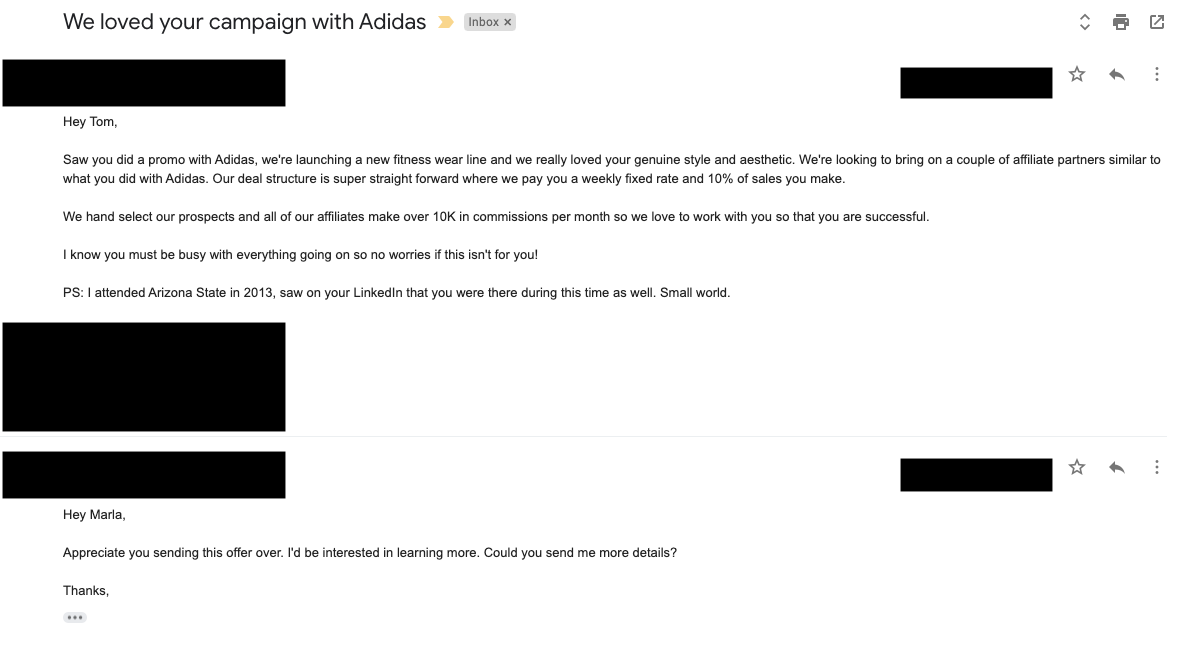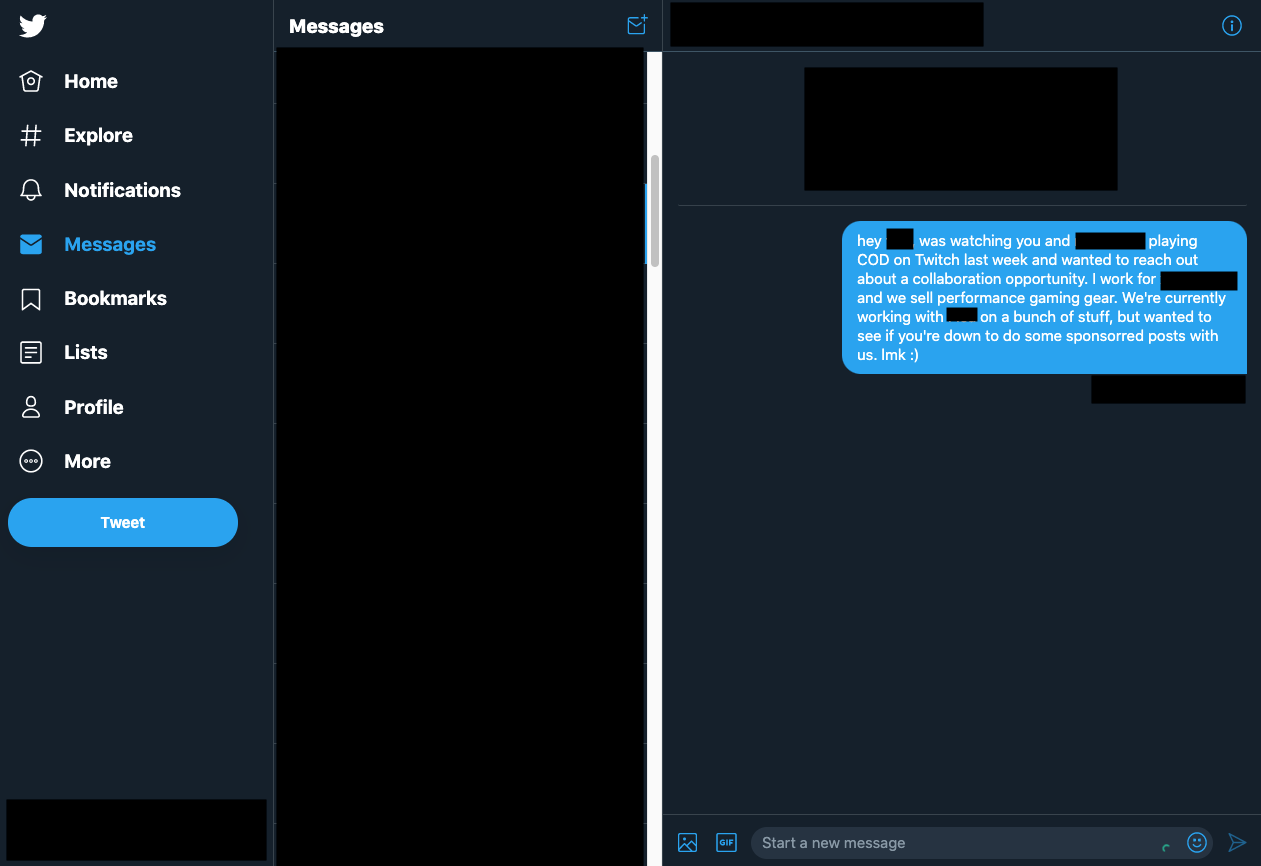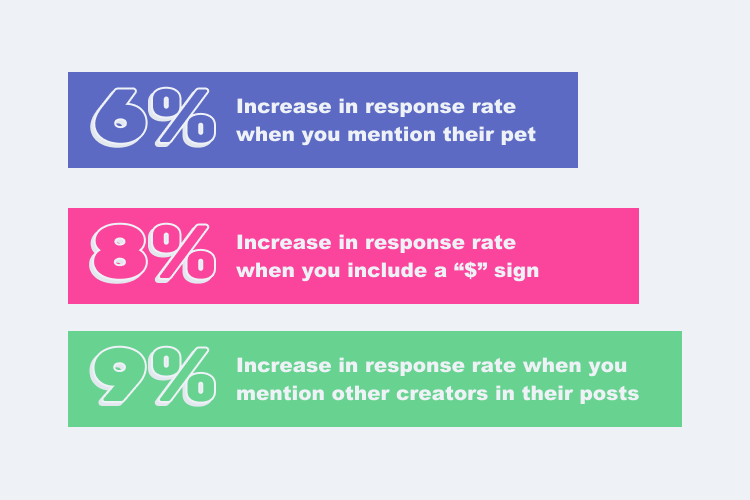Perhaps the most frequent question we get here at Dovetale is how to properly reach out to potential partners. We’re going to break down real conversations, data, cold email techniques, and best practices when reaching out to specific partners such as influencers, affiliates, fans, customers, and more.
Cold Email Techniques
First things first, in order to effectively reach out to potential partners, you’ll need to master some fundamental techniques when reaching out. This guide will help craft your cold outreach emails to get in touch with anyone. Will focus on how to structure your words carefully to achieve your desired outcome increase and increase your response rates.
Before we jump in there are 3 things you need to assume:
- By default, no one cares about you
- People are busy
- People only care about themselves, you need to demonstrate the value
Step 1: Research
If you’re serious about contracting a partner, you should know what they are interested in, what they are working on, and what gets them excited. Even if you spend a couple of minutes on LinkedIn, Instagram, or Twitter getting to know what motivates this person it will give you a big leg up when constructing your cold email.
Pro Tip: Comment, tag and interact, but don’t spam. It will make you feel like less of a stranger when you reach out to them.
Pro Tip: Subscribe to their email newsletters and reply back to them with helpful tips or good questions.
Step 2: Get the Contact Information
Dovetale has a massive contact database with millions of emails. Just search the Instagram handle and we should be able to populate the email address. If you can’t find the email on Dovetale, there are so many tools. Here are some of them:
- Dovetale (good for finding influencer email addresses, starts at $99/mo)
- Apollo (good for business emails, starts at $49/mo)
- Hunter (good for business emails, starts at $49/mo)
- Whois (if you’re looking for the owner of a web domain)
- DuckDuckGo - this trick will only work if you know their email domain. Just search for “@websitename.com” and the full name of your partner. This should show you all of the places that reference this person’s email address.
Step 3: The Email
The Subject:
The subject of your email should be catchy, but not spammy. Ideally, it is relevant to their interest. Sometimes, there is no subject and it works, but here are some more structured examples that we have seen work:
- I saw you on Netflix…
- re: We saw your post with Nike and have another opportunity for you
- Your dog is cute (people love when you talk about their pets)
Contents:
Start your email with a hook. You need to capture their attention and one of the best ways to do this is by referencing something you learned about them in step 1. The next part of the email should be something interesting such as a fact or statistic that is highly relevant to them. Third, you’ll want to manufacture urgency. Why do they need what I’m selling now? Why do they need to be involved in my project? Why will this make their life better? Fourth, this is where you make your ask. What do they need to do? Schedule a call? Reply “yes”? Lastly, give them an out. People will trust you a lot more if you say something nice at the end of your email such as, “No worries if you don’t have time right now, just let me know if I can send you a note in the future about collaboration opportunities.”
Pro Tip: Use a “PS:” at the end of your email. Oftentimes, people skip to the bottom to read your email signature to see if you’re legit. If you add a “PS:” it’s likely the next thing they read. If you add a personal touch, it’s a great way to engage them and entice them to read the rest of the email.
Pro Tip: Use gifs, make people laugh
Pro Tip: Use a happy face, but don’t overdo it :)
Step 4: Follow up
Remember the three things I said above? People are busy and by default, they don’t care about you… In sales and any other partnership outreach, the follow-up is the most important part of the process. You might think it’s rude or annoying, but that’s only true if you’re not adding value. Make sure your follow-ups have insights or create scarcity. Sometimes it takes 20+ emails/ DM’s to get in touch with people.
Pro Tip: People like to be associated with winners and winning brands. Send them a follow-up with progress.
Pro Tip: Make people smile
Best Practices: Types
Brands categorize partners in a variety of ways. Below are some best practices when reaching out to different types of partners. You’ll notice that some people could be a combination of one of more of these terms such as an influential customer, a celebrity promoting an affiliate code, etc. We’ll break down some tips for each category, but feel free to combine best practices.
Influencers
Self-proclaimed “influencers” are often those that get paid to create and post something on social media. If you’re asking an influencer to post for you:
- Be straight up and tell them how much you are planning to pay them. Our recommendation is to discount your pitch by 20% so when they ask for more (they always do), you can easily bring your price up.
- Tell them that you will give them 95% control on the creative direction as long as they hit minimum criteria
Advocates
Advocates are generally people that are already fans of your product/ service. You can easily find your influencer advocates by searching your brand handle on the mentions section on Dovetale. Make sure to:
- Cheerlead. Have someone senior reach out to advocates saying they loved the post/ shoutout.
- Gifting. You’ll get a lot of earned media if you send people a gift, especially if they are already organically talking about you.
Affiliates
Affiliates operate on the tails of the gaussian. There are either super sophisticated affiliates or beginners. Rarely people in the middle. Some tips:
- Give them examples of real advocacy content and make it easy for them to picture themselves doing it for you.
- Highlight how much some of your affiliates are making in commission. If you can give exact examples that have similar followings, even better!
- When you’re working together, create a process and regularly check-in
- Give them creative control, similar to the influencer tips above.
Creators
Creators, for sake of discussion here, are those that purely create content for you. There are a couple of tips here:
- Set your expectations as soon as possible
- Discuss $’s as soon as possible and make sure everyone is on the same page
- Include rates and discuss money in your first outreach
Customers
Customers are purely those that have bought products from you. Perhaps they are influencers or celebrities as well, but we’ll just assume they are strategic for you to reach out for some reason.
- Customers love being reached out to for product feedback and reviews, especially repeat buyers. When customers get involved in product decisions they tell their friends. Lean into this. Talk about how you care about their experience, feedback, and more.
Ambassadors
Ambassadors are people that you are engaging with on a long term basis. It’s a term that a lot of brands use, so we’ve included it here.
- Be clear that you are looking for a long term financial relationship
- Set expectations and make sure the team is on the same page regarding budget, marketing, and requirements
- Your main call to action should be to set a meeting. Include a Calendly link and get on a video call. If it makes sense to meet in person do that as well.
Fans
Fans are those that aren’t necessarily buyers, they just like what you do. Fans could be influencers and it’s an underrated performance marketing segment in our opinion.
- Send them a gift. What better way to get behind a brand that you already love?
Celebrities
Celebrities almost always have an agency or representation of some kind. Be ready to pay 20-40% just to the agency to broker the deal.
- Get the agent’s contact information and reach out directly. It will save you time.
- Read up on negotiation, you’ll need it :)
Associates
Some brands consider their employee advocates, associates. Our recommendations are to:
- Enrich employee data as much as you can to find high-value relationships. Are they already talking about your products/ services on social media? Do they have a large social following?
- Get the head of marketing to send them a message and hold a focus group as your first touchpoint.
- After they feel more engaged and involved in internal advocacy strategies, present them with your ask.
Insiders
Insiders are people privy to non-public information. Often, these insider networks are built to test products early and help give teams feedback - you trust their opinions because they’re experts.
- Get an NDA signed from each member
- Reach out with a confidentiality notice on the email. It will help you get their attention.
- Explain in clear language what the insider program is about and what the perks are
Best Practices: By Platform
Twitch
- Many influencers on Twitch love Twitter and don’t have huge followings (generally). DM them there, you’re much more likely to get noticed.
- Instagrammers get DM’s all the time. Instagram has partitioned tabs that filter out spam and non-connection messages. If you’re a big brand or verified, DM’ing works pretty well, but if you’re not, stick to email.
- Follow up 5+ times. Most people don’t manage their email very well. Be persistent and constantly provide value in each follow-up.
- Look for their business contact information in their bio. DM’ing influencers over 200K followers on Instagram will likely be a waste of time.
YouTube
- YouTuber’s are pretty good at responding to direct messages. A lot of them are familiar with collaboration opportunities and have rate cards/ packages. Ask them to send over their pricing options and be transparent.
- DMing big-timers don’t work that well. Mentioning them on Twitter can work really well and make you feel like less of a stranger when you reach out to them in an email. Keep your profile picture consistent across channels so they recognize you.
TikTok
- Similar to Twitch, many have a Twitter account and don’t have as many followers there. Many TikTok’ers are also trying to establish their YouTube page so their following is a lot smaller there. The general rule of thumb is to reach out to the channel with the least amount of followers.
Examples
An effective affiliate campaign cold outreach

This brand manager actually got a response via email but said that the Twitter DM helped to capture attention.

 Dovetale
Dovetale

